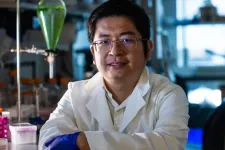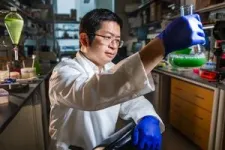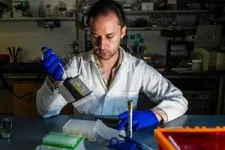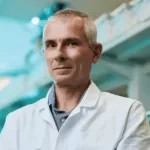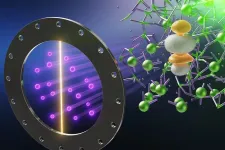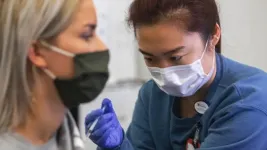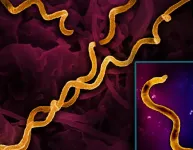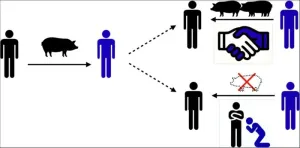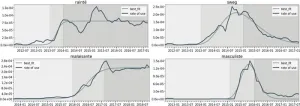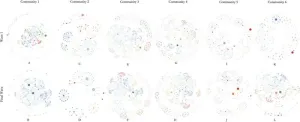(Press-News.org) HOUSTON – (Sept. 3, 2024) – As far as water gear goes, floaties are not exactly high tech. But the tiny air-filled bubbles some microorganisms use as flotation devices when they compete for light on the water surface are a different story.
Known as gas vesicles (GVs), the micrometer-sized bubbles hold great promise for a host of biomedical applications, including imaging, sensing, cellular manipulation and tracking and more. The problem is researchers do not yet know how to make medically useful GV varieties in the lab.
Rice University bioengineers have now created a road map showing how a group of proteins interact to give rise to the bubbles’ nanometer-thin shell. By detangling some of the complex molecular processes that take place during GV assembly, Rice bioengineer George Lu and his team in the Laboratory for Synthetic Macromolecular Assemblies are now one step closer to unlocking powerful new diagnostics and therapeutics based on these naturally occurring structures.
“GVs are essentially tiny bubbles of air, so they can be used together with ultrasound to make things inside our bodies visible such as cancer or specific parts of the body,” said Manuel Iburg, a Rice postdoctoral researcher who is the lead author on a study published in The EMBO Journal. “However, GVs cannot be made in a test tube or on an assembly line, and we cannot manufacture them from scratch.”
The family of GVs includes some of the smallest bubbles ever made, and they can subsist for months. Their stability over longer durations is due largely to the special structure of their protein shell, which is permeable to both individual water and gas molecules but has an inner surface that is highly water-repellent ⎯ hence the GVs’ ability to keep gas in even as they are submerged. And unlike synthetic nanobubbles, which are supplied with gas from without, GVs harness gas from the surrounding liquid.
The water-dwelling photosynthetic bacteria that use GVs to float closer to sunlight have specific genes encoding for the proteins that make up this special shell. However, despite knowing just how the tiny bubbles look and even why they tend to cluster together, researchers have yet to figure out the protein interactions that enable the structures’ assembly process. Without some insight into the workings of these protein building blocks, plans for deploying lab-engineered GVs in medical applications have to be placed on hold.
To address the problem, the researchers honed in on a group of 11 proteins they knew were part of the assembly process and figured out a method to track how each of them, in turn, interacts with the others inside the living parent cells.
“We had to be extremely thorough and constantly check whether our cells were still making GVs,” Iburg said. “One of the things we learned is that some of the GV proteins can be modified without too much trouble.”
The researchers used this insight to add or subtract certain GV proteins as they were running the tests, which allowed them to figure out that interactions between some of the proteins required help from other proteins in order to unfold properly. They also checked whether these individual interactions changed over the course of the GV assembly process.
“Through many such permutations and iterations, we created a road map showing how all these different proteins have to interact to produce a GV inside the cell,” Iburg said. “We learned from our experiments that this road map of GV interactions is very dense with many interdependent elements. Some of the GV proteins form subnetworks that seem to perform a smaller function in the overall process, some need to interact with many of the other parts of the assembling system, and some change their interactions over time.”
“We think GVs have great potential to be used for new, fast and comfortable ultrasound-based diagnosis or even treatment options for patients,” said Lu, an assistant professor of bioengineering at Rice and a Cancer Prevention and Research Institute of Texas (CPRIT) Scholar. “Our findings can also help researchers develop GVs that enable existing treatments to become even more precise, convenient and effective.”
The study was supported by CPRIT (RR190081), the National Institutes of Health (R00EB024600, R21EB033607), the Welch Foundation (C-2069), the G. Harold and Leila Y. Mathers Foundation (MF-2012-01314), John S. Dunn Foundation and the German Research Foundation (511048568). The content in this press release is solely the responsibility of the authors and does not necessarily represent the official views of the funders.
-30-
This news release can be found online at news.rice.edu.
Follow Rice News and Media Relations via Twitter @RiceUNews.
Peer-reviewed paper:
“Elucidating the Assembly of Gas Vesicles by Systematic Protein-Protein Interaction Analysis” | The EMBO Journal | DOI: 10.1038/s44318-024-00178-2
Authors: Manuel Iburg, Andrew Anderson, Vivian Wong, Erica Anton, Art He and George Lu
https://doi.org/10.1038/s44318-024-00178-2
Download associated media:
https://drive.google.com/drive/folders/1A_PpIjGSVMB4OVPs7iyH7-ZwJL-Ov9eF?usp=drive_link
About Rice:
Located on a 300-acre forested campus in Houston, Rice University is consistently ranked among the nation’s top 20 universities by U.S. News & World Report. Rice has highly respected schools of architecture, business, continuing studies, engineering, humanities, music, natural sciences and social sciences and is home to the Baker Institute for Public Policy. With 4,574 undergraduates and 3,982 graduate students, Rice’s undergraduate student-to-faculty ratio is just under 6-to-1. Its residential college system builds close-knit communities and lifelong friendships, just one reason why Rice is ranked No. 1 for lots of race/class interaction, No. 2 for best-run colleges and No. 12 for quality of life by the Princeton Review. Rice is also rated as a best value among private universities by Kiplinger’s Personal Finance.
END
Rice lab develops protein assembly road map for gas vesicles
Nature-derived nanobubbles could enable biomedical applications
2024-09-03
ELSE PRESS RELEASES FROM THIS DATE:
Study: Late start of COVID treatment may still benefit immunocompromised patients
2024-09-03
ATLANTA — Starting antiviral treatment as late as 14 days after infection with SARS-CoV-2 may still be beneficial in hosts with compromised immune systems, who are at greatest risk of developing severe COVID-19, according to researchers in the Center for Translational Antiviral Research at Georgia State University’s Institute for Biomedical Sciences.
While best to begin treatment earlier, in immunocompromised hosts, drugs like paxlovid and molnupiravir appear to inhibit replication of the virus even if initiated up to 14 days after infection.
The ...
Assorted, distinctive behavior of molten uranium salt revealed by neutrons
2024-09-03
Assorted, distinctive behavior of molten uranium salt revealed by neutrons
The Department of Energy’s Oak Ridge National Laboratory is a world leader in molten salt reactor technology development — and its researchers additionally perform the fundamental science necessary to enable a future where nuclear energy becomes more efficient. In a recent paper published in the Journal of the American Chemical Society, researchers have documented for the first time the unique chemistry dynamics and structure of high-temperature liquid uranium trichloride ...
NASA's mini BurstCube mission detects mega blast
2024-09-03
The shoebox-sized BurstCube satellite has observed its first gamma-ray burst, the most powerful kind of explosion in the universe, according to a recent analysis of observations collected over the last several months.
“We’re excited to collect science data,” said Sean Semper, BurstCube’s lead engineer at NASA’s Goddard Space Flight Center in Greenbelt, Maryland. “It’s an important milestone for the team and for the many early career engineers and scientists that have been part of the mission.”
The ...
ESMO Congress 2024
2024-09-03
Lugano, Switzerland, 3 September 2024 – The ESMO Congress 2024 will take place from September 13-17 in Barcelona, bringing together participants from all over the world. Press representatives eager to grasp cutting-edge data and hearing expert perspectives on the latest research, as well as on the current and emerging hot topics in oncology, are invited to attend the event, which will be held both onsite and remotely.
The full congress program is available online to help press representatives browse regular and late-breaking abstract ...
Prestigious NSF award to advance UK research to track emerging pathogens
2024-09-03
We all have lived through a pandemic, its uncertainties, challenges, losses and scientific breakthroughs. A prestigious award from the U.S. National Science Foundation (NSF) is advancing the work of a team of researchers at the University of Kentucky to help society be better prepared for potential future pandemics.
Scott Berry, Ph.D., an associate professor in the Department of Mechanical and Aerospace Engineering in the UK Stanley and Karen Pigman College of Engineering, is the principal investigator ...
NIH awards will support innovation in syphilis diagnostics
2024-09-03
The National Institutes of Health’s National Institute of Allergy and Infectious Diseases (NIAID) has awarded grants for 10 projects to improve diagnostic tools for congenital and adult syphilis—conditions currently diagnosed with a sequence of tests, each with limited precision. The Centers for Disease Control and Prevention (CDC) estimates that adult and congenital syphilis cases increased by 80% and 183% respectively between 2018 and 2022—a crisis that prompted the U.S. Department of Health and Human Services (HHS) to establish a national taskforce to respond to the epidemic.
“Syphilis ...
Explaining the mechanism of social evolution driven by gift giving
2024-09-03
New findings provide quantitative criteria for classifying social organizations in human history, together with potential explanatory variables that can be empirically measured for anthropology, history, and archaeology, according to a study published September 3, 2024 in the open-access journal PLOS Complex Systems by Kenji Itao and Kunihiko Kaneko from the University of Tokyo, Japan and Copenhagen University, Denmark (Kaneko) and the RIKEN Center for Brain Science, Japan (Itao).
Human societies have experienced transitions between different types of organizations, including bands, tribes, chiefdoms, and kingdoms. However, quantitative characterizations of the types and mechanisms of ...
How do new words arise in social media?
2024-09-03
The more centrally connected someone is within their social media network, the more likely that new words they use will become adopted into mainstream language, according to a new study published this week in PLOS Complex Systems by Louise Tarrade of École Normale Supérieure, France, and colleagues.
Language evolves within a social context and variations in a language are always in competition with each other. In everyday language, words are constantly being created, but not all these words persist.
In the new study, researchers analyzed more than 650 million tweets written in French between 2012 and 2014 to identify ...
In US community efforts to prevent childhood obesity, women leaders with more experience and connections have the greatest impact
2024-09-03
In US community efforts to prevent childhood obesity, women leaders with more experience and connections have the greatest impact.
####
In your coverage, please use this URL to provide access to the freely available article in PLOS Complex Systems: https://journals.plos.org/complexsystems/article?id=10.1371/journal.pcsy.0000004
Article Title: Determinants and facilitators of community coalition diffusion of prevention efforts
Author Countries: United States
Funding: TM, MP, and CE received funding from the ...
Guidelines to steer the future of autonomous trucking
2024-09-03
After four years, a guidebook for the future of autonomous trucking has driven across the finish line.
In 2020, the Virginia Tech Transportation Institute (VTTI) and 17 partners were awarded a $7.5 million grant from the U.S. Department of Transportation to develop a concept of operations. The final report, published in July, includes best practices for the implementation of automated driving systems (ADS) in large trucks and policy issues for fleets to consider across eight topic areas.
“We’re excited that the Federal Motor Carrier ...
LAST 30 PRESS RELEASES:
New modeling approach sheds light on rare gut disease
Study documents potentially hazardous flame retardants in firefighter gear
Can certain bacteria regulate aging of the immune system and its related alterations?
AI model helps diagnose often undetected heart disease from simple EKG
There are fewer online trolls than people think
Cell membrane fluctuations produce electricity
Jeonbuk National University study shows positive parenting can protect adolescents against self-harm
Surface-engineered ZnO nanocrystals to tackle perfluoroalkyl substance contamination
This new understanding of T cell receptors may improve cancer immunotherapies
A new fossil face sheds light on early migrations of ancient human ancestor
A new immunotherapy approach could work for many types of cancer
A new way to diagnose deadly lung infections and save lives
40 percent of MRI signals do not correspond to actual brain activity
How brain-inspired algorithms could drive down AI energy costs
Gum disease may be linked to plaque buildup in arteries, higher risk of major CVD events
Contrails are a major driver of aviation’s climate impact
Structure of dopamine-releasing neurons relates to the type of circuits they form for smell-processing
Reducing social isolation protects the brain in later life
Keeping the heart healthy increases longevity even after cancer
Young adults commonly mix cannabis with nicotine and tobacco
Comprehensive review illuminates tau protein's dual nature in brain health, disease, and emerging psychiatric connections
Book prepares K-12 leaders for the next public health crisis
Storms in the Southern Ocean mitigates global warming
Seals on the move: Research reveals key data for offshore development and international ecology
Sports injuries sustained during your period might be more severe
World's first successful 2 Tbit/s free-space optical communication using small optical terminals mountable on satellites and HAPS
Can intimate relationships affect your heart? New study says ‘yes’
Scalable and healable gradient textiles for multi‑scenario radiative cooling via bicomponent blow spinning
Research shows informed traders never let a good climate crisis go to waste
Intelligent XGBoost framework enhances asphalt pavement skid resistance assessment
[Press-News.org] Rice lab develops protein assembly road map for gas vesiclesNature-derived nanobubbles could enable biomedical applications
